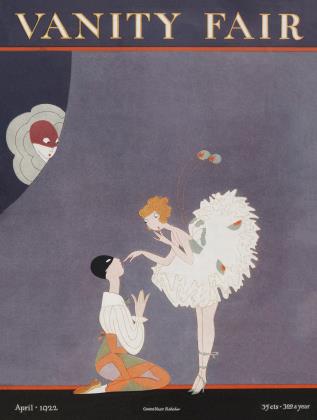Sign In to Your Account
Subscribers have complete access to the archive.
Sign In Not a Subscriber?Join NowThe Theatrical Callboard
Critical Notes Before the Curtain Rises
KENNETH MACGOWAN
THE most important theatrical events of March—perhaps of the whole season—will easily be the completion by the Theatre Guild of its cycle of Shavian performances, Back to Methuselah, and the premieres of two new plays by Eugene O'Neill, The Hairy Ape and The First Man. Shaw's 30,-000-year survey of creation has been in print some six or eight months, and its five component plays have been much discussed in these and other columns; the only questions are, how the Guild will surmount the difficulties of settings and casts, and whether, as in Heart-break House, this disputatious playwright will act far better than he reads. O'Neill's plays, on the other hand, are unknown to the public, and one at least of them is so radical in technique as to seem the most daring piece of playwriting yet produced by any American dramatist of repute.
O'Neill as Expressionist
THE Hairy Ape is an extraordinary leap forward for a man who has already advanced more rapidly in his art than any playwright that our country has produced. Actual performance by the Provincetown Players may vitiate its power, may make its violence and extravagance ridiculous. But in manuscript the play seems a work of uncommon accomplishment. Its force is overpowering; its vision of life is devastating in its pessimism, and it accomplishes its technical purpose with a mastery of a new form even more complete than O'Neill's mastery of the old.
Following out a tendency displayed in The Emperor Jones, O'Neill has plunged ahead clean out of the realism of which he has been arch-priest. His language is still the language of the streets, but he does not crib it in by the plausibilities of time or place or by the inexpressiveness of the human animal. This stoker of his, this hairy ape, speaks in such vivid slang as is practically unknown in our dramatic art, and he speaks his whole soul through it. His inner emotions and the beginnings of thought pour out of him in an extraordinary and rhythmic flow of profanity and exultation and despair. In all the eight scenes of the play there is no line that is not possible to the character that speaks it, no moment of unnatural romance or forced philosophy. Yet O'Neill has put together the words of the stoker in such torrential speeches that every atom of the man's nature lies quivering before us. And about him moves the conventional world in sharp concentrated simulacra. The nearest parallel I can find for the unfettered vitality of The Hairy Ape is in the "expressionist" dramas of the new German stage; and even such a play as Georg Kaiser's From Morn to Midnight seems twisted and unrealized beside the direct and easy accomplishment of The Hairy Ape.
"The First Man"—O'Neill Realism
WHILE the Provincetown Players are mounting the latest work of O'Neill, Augustin Duncan and the Neighborhood Playhouse have been collaborating on another of his dramas, the fourth to be presented in New York this season. Personally, I feel that The First Man is artistically a play out of the dramatist's past. It follows The Straw by three years and Anna Christie by a year; but it lies two plays behind The Hairy Ape; while its immediate successor, The Fountain, as yet unproduced, is a free and almost lyrical drama of the Spanish exploration. The First Man is as sober a piece of realism as Diff'rent, if not so tragic or so powerful. With the many aids and limitations of the Ibsenic form, it tells all that can be said in this way about a spiritual tangle in the lives of a devoted couple. It may win success and The Hairy Ape may crash down under the weight of the difficulties it presents to actor and director; yet O'Neill's future lies along the new way and he must follow it.
The Plays of O'Neill
BECAUSE O'Neill is the figure he is in our theatre, it seems worth while to set down the names and dates of all that he has written in nine years of activity:
1913
A Wife for a Life—one act, destroyed. The Web—one act, published 1914 with four succeeding plays. Thirst—one act.
1914
Recklessness—one act. Warnings—one act. Fog—one act. Bread and Butter —four acts, destroyed. Servitude— three acts, destroyed. Bound East for Cardiff—one act. Abortion—one act, destroyed.
1915
A Knock at the Door—one act comedy, destroyed. The Sniper—one act, produced by Provincetown Players (1917), destroyed. The Personal Equation— four acts, destroyed. Belshazzar—Biblical play in six scenes, destroyed.
1916
Before Breakfast—one act. The Movie Man—one act comedy, destroyed. Now I Ask You—three act farce-comedy, destroyed. Atrocity—one act pantomime, destroyed.
1917
lie—one act. In the Zone—one act. The Long Voyage Home—one act. The Moon of the Caribbees—one act. The G. A. N.—one act farce-comedy, destroyed.
1918
Till We Meet—one act, destroyed. The Rope—one act. Beyond the Horizon— three acts, 6 scenes, produced 1920. The Dreamy Kid—one act. Shell-Shock —one act, destroyed. Where the Cross is Made—one act. The Straw—three acts, five scenes, produced 1921.
1919
Honor Among the Bradleys—one act, destroyed. Chris—three acts, six scenes, produced out of town 1920, destroyed. The Trumpet—one act comedy, destroyed. Exorcism—one act, produced 1920, destroyed.
1920
Gold—four acts, produced 1921. Anna Christie—four acts, produced 1921. The Emperor Jones—eight scenes, produced 1920. Diff'rent—two acts, produced 1920.
1921
The First Man—four acts. The Fountain—prolog and nine scenes. The Hairy Ape—eight scenes.
 View Full Issue
View Full Issue












Subscribers have complete access to the archive.
Sign In Not a Subscriber?Join Now